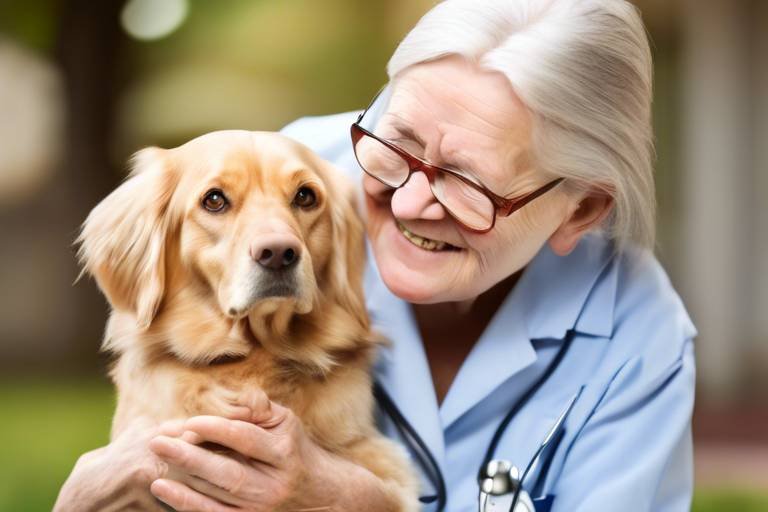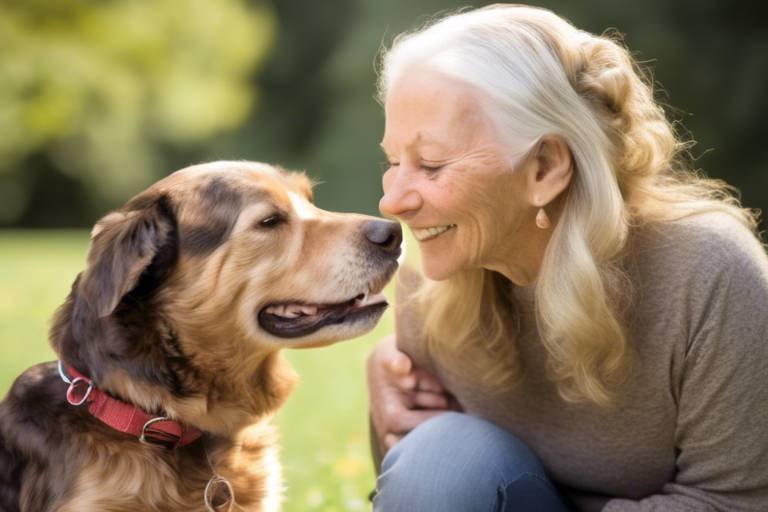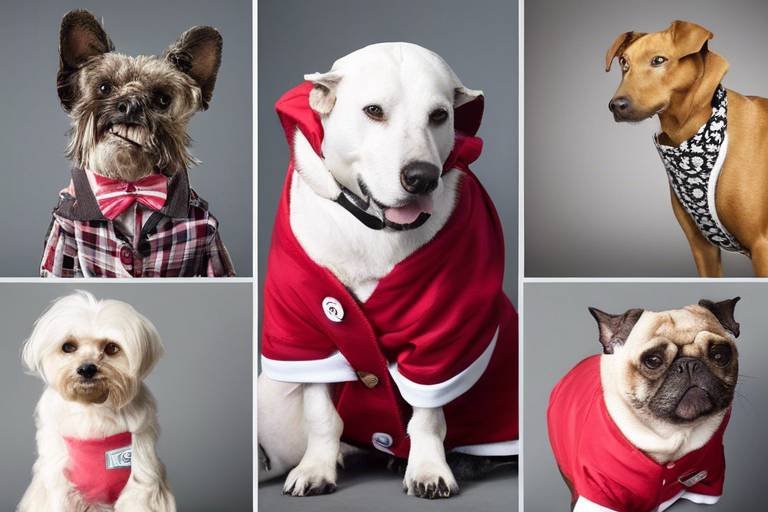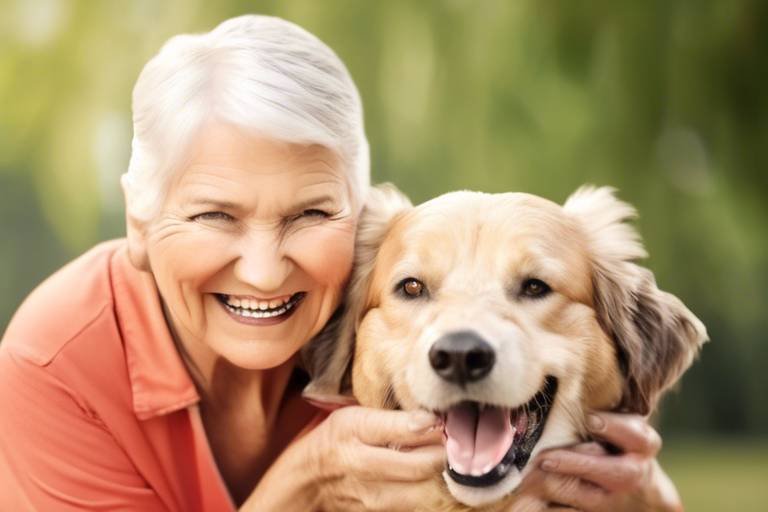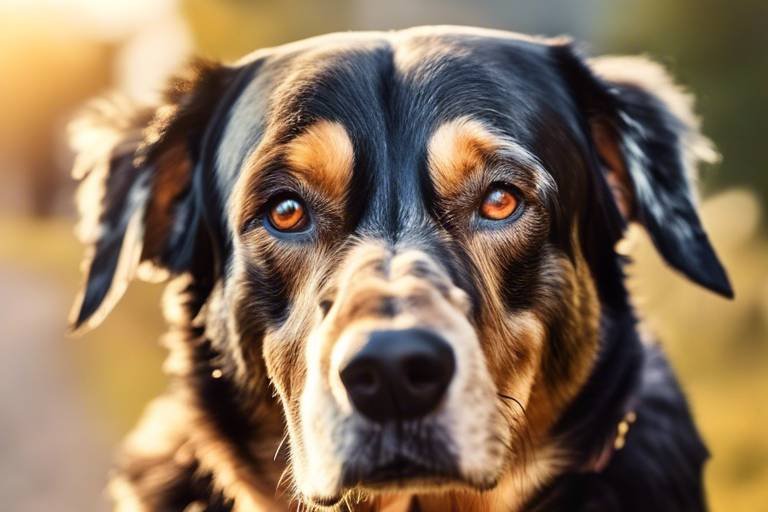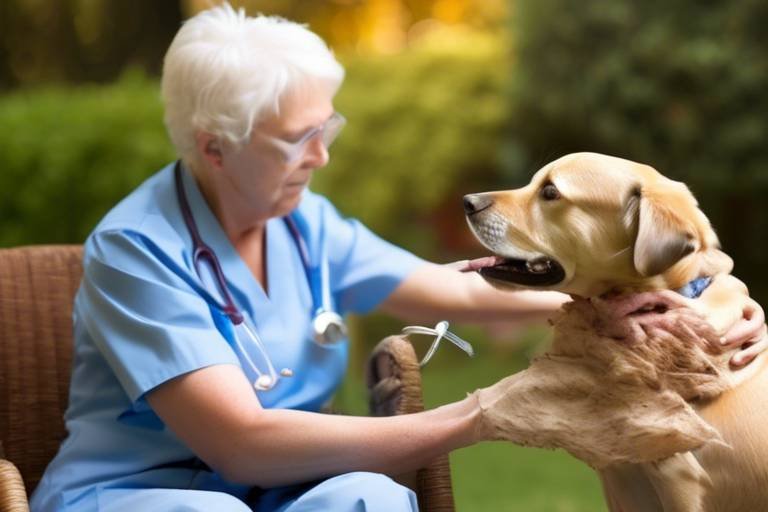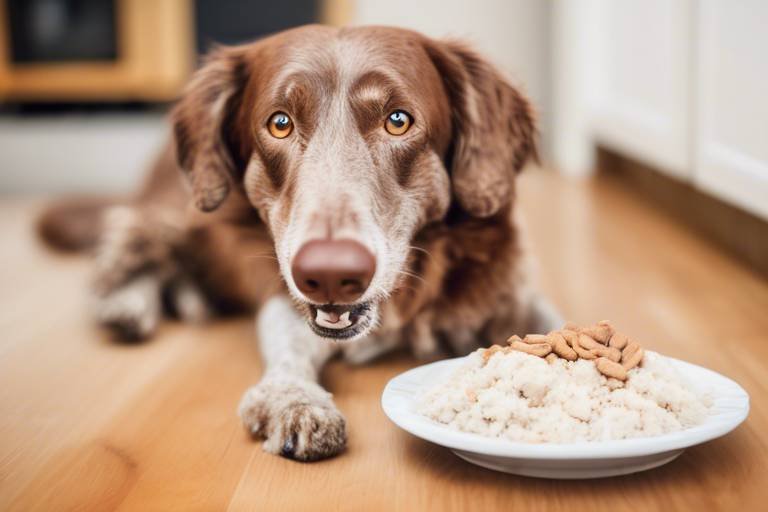Understanding the Special Needs of Senior Rescue Pets
Adopting a senior rescue pet is like opening a beautifully aged book; it’s filled with stories, experiences, and a wealth of love just waiting to be shared. However, this journey comes with its unique set of challenges and requirements that every potential pet parent should be aware of. Senior pets, much like fine wine, require special care and attention to truly flourish in their new environment.
First and foremost, it’s essential to understand that senior rescue pets often come with a history that may include trauma, abandonment, or health issues. This background can lead to specific physical, emotional, and social needs that differ significantly from those of younger animals. By being aware of these unique challenges, you can provide a nurturing and supportive atmosphere that allows your furry friend to thrive.
When you welcome a senior rescue pet into your home, you’re not just offering them a place to live; you’re giving them a chance at a new life filled with love, comfort, and security. This article will delve into the various aspects of caring for senior rescue pets, ensuring that you’re well-equipped to meet their needs and provide them with the best quality of life possible.
Let’s embark on this heartwarming journey together and explore the special needs of our beloved senior rescue pets!
Senior rescue pets often face various health issues that can affect their quality of life. As they age, their bodies undergo changes that may require adjustments in their care routine. Understanding their specific physical needs, including diet, exercise, and regular veterinary care, is crucial for their well-being. For instance, many older pets suffer from arthritis or dental problems, which can make it challenging for them to move around or eat comfortably.
Regular veterinary check-ups become even more important as pets age. These visits can help identify potential health problems early on, allowing for timely intervention. Moreover, keeping an eye on their weight is essential, as obesity can exacerbate existing health issues. A well-balanced diet tailored to their age and health conditions can make a significant difference in their overall health.
The emotional needs of senior rescue pets can be complex. These animals may have experienced significant trauma in their past, making it essential to provide a safe and loving environment that helps them adjust and thrive. A nurturing atmosphere can significantly reduce anxiety and fear, allowing your senior pet to feel secure and loved.
Recognizing signs of stress and anxiety in senior pets is crucial. These signs may include:
- Excessive barking or meowing
- Hiding or seeking solitude
- Changes in eating or drinking habits
- Destructive behavior
Understanding these behaviors allows caregivers to implement strategies that promote comfort and security. For example, creating a quiet space where your pet can retreat when feeling overwhelmed can work wonders for their emotional state.
Establishing a designated safe space for senior rescue pets can significantly enhance their emotional well-being. This space can be a cozy corner with their favorite blanket, toys, and a bed where they can retreat when they feel anxious. It’s like having their personal sanctuary, a place where they can relax and feel secure.
Building trust with senior rescue pets requires patience and understanding. These animals may not immediately warm up to you, and that’s perfectly okay. Gradual interactions, positive reinforcement, and plenty of love can help them feel secure in their new environment. Think of it as planting a seed; with time, care, and nurturing, it will blossom into a beautiful relationship.
Socialization is vital for senior rescue pets. Gradual exposure to new experiences and environments can help them adjust and reduce fear of the unfamiliar. Whether it’s meeting new people or exploring new places, positive experiences can enhance their quality of life and help them become more confident.
Proper nutrition is essential for the health of senior rescue pets. As pets age, their dietary needs change, and understanding these requirements can help prevent obesity and other health issues. A balanced diet that caters to their age and health conditions is crucial for maintaining their vitality.
Selecting age-appropriate food is crucial for senior pets. Nutrient-rich diets tailored to their health conditions can enhance their quality of life. Always consult with your veterinarian to determine the best food options for your pet, ensuring they receive the right balance of nutrients.
Ensuring senior rescue pets remain hydrated is vital. Access to fresh water and understanding their hydration needs can prevent common health issues, such as urinary tract infections and kidney problems. Encourage your pet to drink by providing fresh water daily and considering water fountains, which many pets find more appealing.
1. How can I help my senior rescue pet adjust to their new home?
Creating a calm and predictable environment, establishing a routine, and providing plenty of love and patience can help your senior pet feel secure in their new surroundings.
2. What should I do if my senior pet shows signs of anxiety?
If your pet exhibits signs of anxiety, consult your veterinarian for advice on behavioral strategies or potential treatments that can help alleviate their stress.
3. How often should I take my senior pet to the vet?
Senior pets should ideally visit the veterinarian at least twice a year for regular check-ups to monitor their health and catch any issues early.

Physical Health Considerations
When it comes to senior rescue pets, their physical health is paramount. As these furry friends age, they often encounter a range of health issues that require special attention. It’s crucial for pet owners and caregivers to understand these unique challenges to provide the best care possible. From dietary needs to exercise routines, every aspect of their health must be carefully considered.
First and foremost, diet plays a significant role in the health of senior pets. Many older animals suffer from obesity, which can lead to a multitude of other health problems, such as diabetes and joint issues. Therefore, it is essential to choose a diet that is not only calorie-controlled but also rich in nutrients. Look for food that contains high-quality protein, healthy fats, and essential vitamins and minerals. A balanced diet tailored to their specific needs can make a world of difference in their overall well-being.
Regular exercise is another critical component of a senior pet's health. While they may not have the energy levels of their younger counterparts, gentle and consistent exercise can help maintain their mobility and prevent weight gain. Activities such as short walks, light playtime, or even swimming can be beneficial. It’s important to remember that every pet is different; some may need more encouragement than others. Always consult with a veterinarian to develop an appropriate exercise plan that suits your pet's abilities.
Additionally, regular veterinary check-ups are essential to monitor the health of senior pets. These visits can help identify potential health issues early on, allowing for timely intervention. A typical check-up might include:
| Examination | Frequency |
|---|---|
| Complete physical exam | Every 6 months |
| Dental check | Annually |
| Blood tests | Every year |
Moreover, keeping an eye on your pet's weight and overall body condition can help catch issues before they escalate. If you notice any sudden changes in weight, appetite, or behavior, it’s vital to consult a veterinarian promptly. Remember, prevention is key when it comes to the health of senior rescue pets.
In summary, addressing the physical health needs of senior rescue pets involves a multifaceted approach. By focusing on proper nutrition, regular exercise, and consistent veterinary care, you can significantly enhance their quality of life. Caring for a senior pet may require more effort, but the love and companionship they provide in return are truly invaluable.

Emotional Well-being
The emotional well-being of senior rescue pets is a critical aspect of their overall health that often gets overlooked. Just like humans, our furry friends experience a range of emotions, and for senior pets, these feelings can be complex. Many of them have faced trauma, abandonment, or neglect in their previous lives, which can leave emotional scars. Thus, providing a safe and loving environment is not just beneficial; it’s essential for their adjustment and happiness. When you bring a senior rescue pet into your home, consider it your mission to create a sanctuary where they can thrive, feel secure, and, most importantly, feel loved.
One of the first steps in ensuring emotional well-being is to recognize that senior pets may have anxiety and fear stemming from their past experiences. Imagine how daunting it must be for them to navigate a new home filled with unfamiliar sights, sounds, and smells. To help ease their transition, it’s vital to establish a routine that provides consistency. This can include regular feeding times, walks, and playtime, which can create a sense of normalcy and predictability in their lives.
Being attuned to the signs of stress and anxiety in senior pets can significantly improve their emotional well-being. Some common indicators include:
- Excessive barking or whining
- Hiding or seeking solitude
- Pacing or restlessness
- Changes in appetite or grooming habits
Recognizing these signs early allows caregivers to implement strategies that promote comfort and security. For instance, if your pet seems anxious during thunder or fireworks, creating a calming environment can help. This might involve playing soothing music, providing a cozy blanket, or even using anxiety wraps designed to provide gentle pressure.
Establishing a designated safe space for your senior rescue pet can significantly enhance their emotional well-being. This space should be a quiet area where they can retreat when feeling overwhelmed. Think of it as their personal hideaway, complete with their favorite blanket, toys, and perhaps a piece of your clothing to provide comfort. This sanctuary not only gives them a sense of security but also empowers them to take control of their environment. When they have a place to escape to, they can recharge and feel more at ease.
Building trust with senior rescue pets is a gradual process that requires patience and understanding. Unlike younger pets, seniors may take longer to warm up to new people and situations. It’s essential to let them set the pace. Gradual interactions, combined with positive reinforcement, can help them feel secure in their new environment. For example, offering treats or gentle praise when they approach you can create positive associations. Over time, they’ll learn that they are in a safe space where they can express themselves freely.
In conclusion, the emotional well-being of senior rescue pets is a multifaceted aspect that demands our attention and care. By recognizing their unique challenges and providing a nurturing environment, we can help them not only adjust but also thrive in their new homes. After all, every pet deserves a chance to experience love and happiness in their golden years.
Q: How can I tell if my senior rescue pet is happy?
A: A happy senior pet will show signs of engagement, such as wagging their tail, seeking affection, and playing with toys. Look for behaviors that indicate they are comfortable and content in their environment.
Q: What should I do if my senior pet shows signs of anxiety?
A: If your pet shows signs of anxiety, try to identify the triggers and create a calm environment. Providing a safe space, using calming aids, and consulting with a veterinarian or a pet behaviorist can also be helpful.
Q: How long does it take for a senior rescue pet to adjust?
A: The adjustment period varies by individual pet. Some may settle in within a few days, while others may take weeks or even months. Patience and consistency are key during this time.
Signs of Stress and Anxiety
This article explores the unique challenges and requirements of senior rescue pets, including their physical, emotional, and social needs, to ensure they receive the best care and love in their new homes.
Senior rescue pets often face various health issues. Understanding their specific physical needs, including diet, exercise, and regular veterinary care, is crucial for their well-being.
The emotional needs of senior rescue pets can be complex. Providing a safe and loving environment helps them adjust and thrive, reducing anxiety and fear.
Recognizing the signs of stress and anxiety in senior rescue pets is essential for their overall well-being. Just like humans, pets can experience a range of emotions, and sometimes they may not express them in ways we easily understand. Common signs to look out for include:
- Excessive Barking or Whining: If your pet is vocalizing more than usual, it might be a sign of distress.
- Hiding or Withdrawal: A senior pet that suddenly retreats to a corner or under furniture may be feeling overwhelmed.
- Changes in Appetite: Stress can lead to overeating or a complete loss of interest in food, which can affect their health.
- Destructive Behavior: Chewing, scratching, or other destructive actions can indicate anxiety and frustration.
- Excessive Grooming: If your pet is licking themselves more than usual, it may be a coping mechanism for stress.
Understanding these signs allows caregivers to implement strategies that promote comfort and security. For instance, if you notice your pet is hiding, try to create a calm environment with minimal noise and distractions. On the other hand, if your pet is displaying destructive behavior, it might be time to engage them in more interactive play or provide them with toys that stimulate their mind.
Establishing a designated safe space for senior rescue pets can significantly enhance their emotional well-being, providing them with a retreat when they feel overwhelmed. This space could be a quiet room with their favorite blanket, toys, and a comfortable bed. Think of it as their personal sanctuary, where they can escape the hustle and bustle of daily life. This safe haven can help them feel secure and relaxed, especially during stressful situations like thunderstorms or loud gatherings.
Building trust with senior rescue pets requires patience and understanding. Just like a fragile flower that needs nurturing, these pets may take time to blossom in their new environment. Gradual interactions and positive reinforcement can help them feel secure. For example, start by spending quiet time together, allowing them to approach you at their own pace. Use treats and gentle words to encourage them, reinforcing the idea that they are safe and loved. Over time, this approach can lead to a strong bond of trust between you and your pet.
Socialization is vital for senior rescue pets. Gradual exposure to new experiences and environments can help them adjust and reduce fear of the unfamiliar.
Proper nutrition is essential for the health of senior rescue pets. Understanding their dietary needs can help prevent obesity and other health issues.
Selecting age-appropriate food is crucial for senior pets. Nutrient-rich diets tailored to their health conditions can enhance their quality of life.
Ensuring senior rescue pets remain hydrated is vital. Access to fresh water and understanding their hydration needs can prevent common health issues.
Q: How can I tell if my senior rescue pet is stressed?
A: Look for signs like excessive barking, hiding, changes in appetite, or destructive behavior. Each pet is unique, so observe their normal behavior for any changes.
Q: What should I do if my pet shows signs of anxiety?
A: Create a safe space for them, engage in gentle play, and consider consulting a veterinarian or a pet behaviorist for further guidance.
Q: Can diet affect my senior pet's mood?
A: Yes, a balanced diet can significantly impact your pet's overall health and mood. Ensure they receive appropriate nutrition tailored to their needs.
Q: How often should I take my senior pet to the vet?
A: Regular check-ups, ideally every six months, are recommended for senior pets to monitor their health and address any issues early on.
Creating a Safe Space
Creating a safe space for senior rescue pets is not just a luxury; it’s a necessity. Imagine being in a new place, surrounded by unfamiliar sounds, smells, and sights. It can be overwhelming! For our furry friends, this can lead to stress and anxiety. Therefore, establishing a cozy retreat within your home can provide them with a sanctuary to feel secure and calm.
When designing this safe haven, consider choosing a quiet area that is away from the hustle and bustle of daily life. This could be a corner of your living room, a cozy nook in the bedroom, or even a dedicated room if space allows. The key is to ensure that it’s a low-traffic area where your pet can retreat when they need a break. You can use soft bedding, blankets, and their favorite toys to make it inviting. Think of it as creating a little oasis where they can escape the chaos of the outside world.
Moreover, it’s essential to include familiar items in their safe space. This could be a blanket or a toy that they had before entering your home. Familiar scents can have a calming effect on pets, helping them feel more at ease. You might also want to include some of their favorite treats or a special chew toy that can keep them occupied and distracted from any anxiety they might be feeling.
Additionally, consider the importance of accessibility. Senior pets may have mobility issues, so ensure that their safe space is easily accessible. Avoid placing their bed in a location that requires them to navigate stairs or jump over obstacles. Instead, keep it simple and straightforward, allowing them to come and go as they please.
It’s also crucial to monitor the environment within this safe space. Keep it free from loud noises, sudden movements, or anything that might startle them. If you have other pets, make sure they understand that this area is off-limits to them, allowing your senior rescue pet to enjoy their sanctuary without feeling threatened or anxious.
Lastly, be patient. It may take time for your senior rescue pet to recognize and appreciate their safe space. Encourage them to use it by gently guiding them there when they seem stressed or overwhelmed. Over time, they will come to see it as their personal retreat, a place where they can relax and feel secure.
In summary, creating a safe space for senior rescue pets is about understanding their unique needs and providing them with a comforting environment. With a little effort, you can help them thrive in their new home, ensuring they feel loved and protected.
- How can I tell if my senior rescue pet is stressed? Look for signs such as excessive barking, hiding, or changes in eating habits. These can indicate that they are feeling anxious.
- What should I include in my pet's safe space? Include comfortable bedding, familiar toys, and a quiet environment to help them feel secure.
- How long does it take for a senior rescue pet to adjust to their new home? Every pet is different, but it can take anywhere from a few days to several weeks for them to feel comfortable.
- Can I train my senior rescue pet to use their safe space? Yes! Use positive reinforcement to encourage them to go to their safe space when they feel overwhelmed.
Building Trust
Building trust with senior rescue pets is a journey that requires patience, understanding, and a sprinkle of love. Imagine being in a new place, surrounded by unfamiliar faces and sounds; it can be pretty daunting, right? For senior rescue pets, this is their reality. They may have experienced trauma or neglect, making it essential to create an atmosphere where they feel safe and valued.
One of the first steps in establishing trust is to allow your new furry friend to set the pace. Rushing interactions can lead to stress and anxiety, which is the opposite of what we want. Instead, try to engage in gentle, low-pressure activities. For example, sitting quietly in the same room can help them feel your presence without overwhelming them. Over time, they may approach you on their own terms, which is a significant milestone in building that essential bond.
Positive reinforcement is another powerful tool in your trust-building arsenal. When your senior pet engages in a desired behavior, whether it's a gentle sniff or a wag of the tail, reward them with a treat or a soft word of encouragement. This not only reinforces good behavior but also associates you with positive experiences. Just like humans, pets thrive on validation and love, so showering them with affection can go a long way.
Moreover, consistency plays a crucial role in building trust. Establishing a routine can help your senior rescue pet feel more secure. This includes feeding times, walks, and play sessions. When they know what to expect, it reduces their anxiety levels and fosters a sense of stability. Consider creating a simple schedule and sticking to it, which can help them adapt more quickly to their new home.
Lastly, remember that every pet is unique. Some may take longer to trust than others. It's important to recognize and respect their individual personalities and past experiences. If your pet seems hesitant, don’t take it personally; it’s a part of their healing process. With time, patience, and love, you can create a bond that is not only strong but also incredibly rewarding.
- How long does it take for a senior rescue pet to trust me?
Trust-building can vary greatly among pets. Some may start to trust you within a few days, while others may take weeks or even months. Patience is key! - What should I do if my senior pet shows signs of aggression?
If your pet displays aggression, it’s essential to give them space and avoid confrontation. Consult a veterinarian or a professional trainer for guidance tailored to your pet's needs. - Can I help my senior rescue pet feel more secure?
Yes! Create a safe, quiet space for them to retreat to, maintain a consistent routine, and offer plenty of positive reinforcement to help them feel secure.
Socialization Needs
When it comes to senior rescue pets, socialization is not just a luxury; it's a necessity. Imagine being uprooted from your familiar surroundings and thrust into a new environment filled with unfamiliar faces and sounds. For many senior pets, this transition can be overwhelming. Just like humans, our furry friends thrive on interaction and connection. They may have spent years in a shelter or a previous home, and now they need to relearn how to navigate the world around them.
One of the key aspects of socialization is gradual exposure. This means introducing your senior pet to new experiences slowly and gently. For example, if you bring home a senior dog, start with short walks in quiet neighborhoods before venturing out to busier parks. This not only helps them adjust but also builds their confidence. You might be surprised at how quickly they adapt when given the right environment and support!
Additionally, it’s essential to recognize that each pet is unique. Some may be more outgoing, while others might be shy or fearful. Understanding your pet's personality can help you tailor their socialization experiences. For instance, if your cat is particularly timid, consider inviting a calm friend over instead of hosting a large gathering. This way, your pet can gradually acclimate to the presence of new people without feeling overwhelmed.
To ensure that the socialization process is effective, positive reinforcement is key. Rewarding your pet with treats or praise when they engage positively with new experiences reinforces their good behavior. It’s like giving them a little pat on the back every time they conquer a fear. Over time, this will help them associate new situations with positive outcomes, making them more likely to embrace change.
Remember, socialization isn't just about meeting new people or pets; it also involves exposing senior rescue pets to various environments and experiences. Whether it's a trip to the vet, a ride in the car, or a visit to a pet-friendly store, these experiences can significantly enhance their quality of life. Below is a quick overview of how to approach socialization:
| Socialization Activity | Tips |
|---|---|
| Meet New People | Start with one person at a time; offer treats and praise. |
| Exposure to Other Pets | Choose calm pets and keep initial meetings short. |
| New Environments | Gradually introduce them to different locations; keep sessions brief. |
In conclusion, socialization is a vital component of a senior rescue pet's adjustment process. By taking it slow, using positive reinforcement, and being mindful of your pet's unique personality, you can help them thrive in their new home. Remember, patience and love go a long way in making your senior pet feel secure and happy!
- How long does it take for a senior pet to adjust to a new home? It varies, but with patience and consistent routines, most pets will start to feel comfortable within a few weeks.
- Can I socialize my senior pet with younger animals? Yes, but ensure that the younger animals are calm and well-behaved to avoid overwhelming your senior pet.
- What if my senior pet shows signs of fear during socialization? Take a step back, give them space, and try again later. It's important to respect their pace.

Nutritional Requirements
When it comes to caring for senior rescue pets, understanding their is absolutely essential. As pets age, their bodies undergo various changes, and these changes can significantly impact their dietary needs. For instance, senior pets may have slower metabolisms, reduced energy levels, and specific health conditions that necessitate a tailored diet. It's not just about feeding them; it's about nourishing them in a way that promotes their overall health and longevity.
One of the first steps in ensuring your senior rescue pet is well-nourished is to choose the right food. Look for pet foods specifically formulated for senior animals, as these often contain lower calories and adjusted nutrient levels to accommodate their changing bodies. For example, senior diets typically have higher fiber content to aid digestion and maintain a healthy weight. Additionally, ingredients rich in antioxidants can help combat the oxidative stress that aging pets experience. It's like giving them a superhero cape to fight off the villains of aging!
Moreover, it’s crucial to pay attention to the ingredients in the food. Avoid products with fillers and artificial additives, as these can do more harm than good. Instead, focus on high-quality proteins, healthy fats, and whole grains. You might even consider consulting with a veterinarian or a pet nutritionist to develop a meal plan that aligns with your pet's specific health conditions, such as kidney disease or arthritis. Think of it as customizing a diet plan for a friend who is on a health journey; every little detail matters!
Another vital aspect of nutrition for senior rescue pets is hydration. Ensuring that your furry friend stays hydrated is paramount. As pets age, they may not drink as much water as they should, which can lead to dehydration and other health issues. Always provide fresh, clean water and consider incorporating wet food into their diet, as it can help increase their water intake. You could even try adding a splash of low-sodium broth to their food to make it more enticing—after all, who doesn’t love a delicious meal?
Here’s a quick table to summarize some key nutritional considerations for senior pets:
| Nutritional Element | Importance |
|---|---|
| High-quality Protein | Supports muscle maintenance and overall health. |
| Healthy Fats | Provides energy and supports skin and coat health. |
| Fiber | Aids digestion and helps maintain a healthy weight. |
| Vitamins & Minerals | Supports immune function and overall well-being. |
| Water | Prevents dehydration and supports kidney function. |
In conclusion, providing the right nutrition for senior rescue pets is a fundamental part of ensuring their well-being. By being mindful of their dietary needs and making informed choices, you can help your furry friend live a healthier, happier life. Remember, it’s not just about what they eat, but how it contributes to their overall quality of life. So, let’s roll up our sleeves and make mealtime a special occasion filled with love and care!
Q: What should I look for in senior pet food?
A: Look for high-quality ingredients, lower calories, increased fiber, and added vitamins and minerals. Make sure it’s specifically formulated for senior pets.
Q: How can I ensure my senior pet stays hydrated?
A: Always provide fresh water, consider wet food options, and try adding low-sodium broth to their meals to encourage drinking.
Q: Should I consult a vet about my senior pet’s diet?
A: Yes! A veterinarian can provide personalized dietary recommendations based on your pet’s health conditions and nutritional needs.
Choosing the Right Food
When it comes to feeding senior rescue pets, making the right choices is essential for their overall health and happiness. As pets age, their nutritional needs change significantly. They may develop specific health issues that require special dietary considerations. For instance, a dog with arthritis may benefit from a diet rich in omega-3 fatty acids, which can help reduce inflammation. Similarly, cats with kidney issues often need lower protein diets to ease the burden on their kidneys.
One of the first steps in choosing the right food is to consult with a veterinarian. They can provide tailored advice based on your pet’s health status, age, and breed. It’s important to consider age-appropriate food, which is specifically formulated for senior pets. These diets typically have fewer calories to help prevent obesity, which is a common issue in older animals. Moreover, they are often fortified with vitamins and minerals that support joint health, digestion, and cognitive function.
Another factor to consider is the ingredient list. High-quality dog or cat food should contain real meat as the first ingredient, along with a balance of carbohydrates, fats, and fiber. Avoid foods with fillers like corn and soy, as they provide little nutritional value. Instead, look for options that include whole grains, vegetables, and fruits, which can provide essential nutrients and antioxidants.
To make the process easier, here’s a simple table to help you understand some common dietary needs for senior pets:
| Health Issue | Recommended Nutritional Focus |
|---|---|
| Obesity | Lower calorie, high fiber diets |
| Arthritis | Omega-3 fatty acids, glucosamine |
| Kidney Disease | Lower protein, higher moisture content |
| Dental Health | Crunchy kibble, dental treats |
Don’t forget about hydration! Senior pets can be prone to dehydration, so ensure they have access to fresh water at all times. Wet food can also be a great addition to their diet, as it provides extra moisture and can be easier to chew for pets with dental issues.
Lastly, always introduce new food gradually. Sudden changes in diet can upset your pet’s stomach. Mix a small amount of the new food with their current food, gradually increasing the new food over a week or so. This slow transition helps avoid digestive issues and allows your pet to adjust to the new flavors and textures.
In conclusion, choosing the right food for senior rescue pets is a blend of understanding their specific needs, consulting with professionals, and being mindful of the ingredients. By providing a balanced, nutritious diet, you can significantly enhance their quality of life and ensure that they enjoy their golden years to the fullest.
- What should I look for in senior pet food? Look for high-quality ingredients, age-appropriate formulations, and specific nutrients that support your pet’s health issues.
- How often should I feed my senior pet? Generally, feeding them twice a day is advisable, but consult your vet for personalized recommendations.
- Can I give my senior pet treats? Yes, but choose healthy options that complement their diet and avoid excessive calories.
- Is it necessary to change my pet's food as they age? Yes, as pets age, their nutritional needs change, and it’s important to adjust their diet accordingly.
Hydration Importance
When it comes to caring for senior rescue pets, hydration is often an overlooked yet crucial aspect of their health. Just like humans, our furry companions rely on water to maintain their bodily functions, regulate their temperature, and support their overall well-being. As pets age, their ability to sense thirst can diminish, making it essential for caregivers to be proactive in ensuring they stay hydrated. Imagine trying to navigate a hot summer day without a refreshing drink—our pets feel the same way!
Senior pets may also have specific health conditions that can further complicate their hydration needs. For instance, pets with kidney disease often require increased water intake to help flush toxins from their system. On the other hand, pets suffering from heart issues may need to limit their fluid intake. This is where understanding your pet's unique health profile becomes vital. Consulting with a veterinarian can provide insights into your pet's hydration needs based on their age, weight, and health status.
To ensure that senior rescue pets are getting enough water, consider implementing the following strategies:
- Fresh Water Availability: Always provide access to fresh, clean water. Change the water daily and clean the bowl regularly to prevent bacteria buildup.
- Encourage Drinking: Some pets may be more inclined to drink from a bowl, while others might prefer a pet fountain. Experiment to see what your pet prefers.
- Wet Food Options: Incorporating wet food into their diet can significantly boost their water intake. Many senior pets enjoy the taste and texture of canned food.
- Flavoring Water: If your pet is reluctant to drink, try adding a splash of low-sodium broth to their water to entice them.
Additionally, monitoring your pet’s hydration status is essential. Signs of dehydration can include dry gums, lethargy, and a lack of skin elasticity. A simple test is to gently pinch the skin on the back of their neck; if it doesn’t quickly return to its normal position, your pet may be dehydrated. If you notice any of these signs, it’s crucial to consult your veterinarian promptly.
In summary, keeping senior rescue pets hydrated is not just about offering water; it’s about understanding their unique needs and making hydration a priority in their daily care. By being attentive and proactive, you can help ensure that your furry friend remains healthy and happy in their golden years.
- How much water should my senior pet drink daily? The general rule is that pets should drink about one ounce of water per pound of body weight daily, but this can vary based on their diet and health conditions.
- What are the signs of dehydration in pets? Look for dry gums, lethargy, sunken eyes, and loss of skin elasticity as indicators of dehydration.
- Can I give my pet flavored water? Yes, adding a small amount of low-sodium broth can encourage your pet to drink more water.
- Is wet food better for hydration? Yes, wet food can significantly increase your pet's water intake and is often more palatable for senior pets.
Frequently Asked Questions
- What are the common health issues faced by senior rescue pets?
Senior rescue pets often encounter a range of health challenges, including arthritis, dental disease, obesity, and heart conditions. Regular veterinary check-ups can help identify and manage these issues early, ensuring your pet stays healthy and happy.
- How can I help my senior rescue pet adjust to their new home?
Creating a calm and secure environment is key. Start by establishing a safe space where your pet can retreat when feeling anxious. Gradual introductions to new areas and experiences, alongside consistent routines, can greatly aid in their adjustment.
- What signs indicate that my senior pet is stressed or anxious?
Look out for behaviors such as excessive barking, hiding, pacing, or changes in eating habits. These signs can indicate that your pet is feeling overwhelmed. Being observant can help you take proactive steps to alleviate their stress.
- How important is socialization for senior rescue pets?
Socialization is crucial for senior rescue pets as it helps them feel more comfortable in various situations. Gradually exposing them to new people, pets, and environments can help reduce their fear and anxiety, making them more adaptable.
- What nutritional needs should I consider for my senior rescue pet?
Senior pets often require diets that are lower in calories but higher in essential nutrients. Look for age-appropriate food that supports joint health and overall well-being. Consulting with a veterinarian can help you choose the best diet for your pet's specific needs.
- How can I ensure my senior rescue pet stays hydrated?
Always provide access to fresh, clean water. Monitor their water intake and encourage hydration, especially if your pet has health conditions that require it. Adding wet food to their diet can also help increase their moisture intake.
- What are some tips for building trust with my senior rescue pet?
Building trust takes time and patience. Use positive reinforcement techniques, such as treats and praise, to encourage good behavior. Allow your pet to approach you on their terms, and avoid overwhelming them with too much interaction too quickly.



